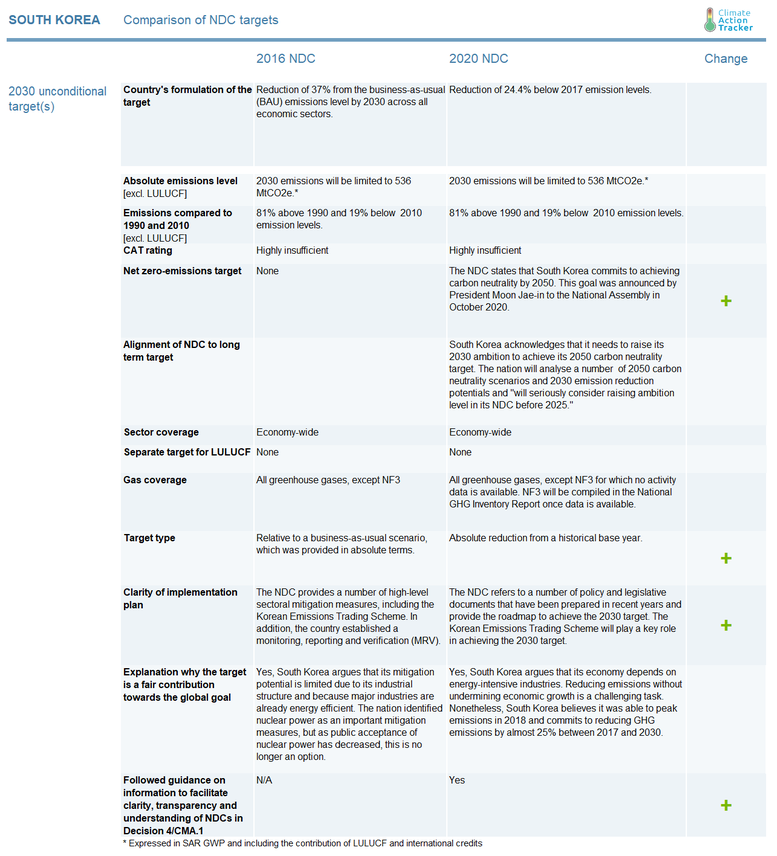CAT Climate Target Update Tracker
South Korea
Summary
In updated NDC, South Korea's target did not change, remains ‘Highly insufficient’
South Korea submitted its updated NDC in December 2020, but did not strengthen the nation’s 2030 target, which the CAT rates as “Highly insufficient”. It has made improvement in the architecture of its NDC as its target is now set as a 24.4% reduction below 2017 emission levels, whereas the previous NDC set a reduction target compared to a business as usual (BAU) scenario. However, the strength of the target remains unchanged at 540 MtCO2e – including contributions of LULUCF and international credits. If these contributions are excluded, we estimate South Korea’s target to correspond to 578 MtCO2e by 2030 or 19% below 2017 levels (see assumptions section).
South Korea still has the opportunity to raise its NDC ambition before COP26 in Glasgow to levels consistent with meeting its stated net zero goals, and should not wait until 2025, as it suggests in its communication.
CAT analysis of NDC


South Korea submitted its updated NDC in December 2020. Compared to its previous submission, South Korea has now put forward an absolute mitigation target instead of a reduction compared to a business as usual (BAU) scenario. Because the previous NDC provided this scenario in absolute terms, the previous NDC target was de facto also absolute. The updated NDC does not change the targeted 2030 emissions level in absolute terms and represents no enhancement of ambition.
The updated NDC aims for a reduction of 24.4% below 2017 levels by 2030, whereas the previous NDC set the goal of reducing business-as-usual emissions by 37% by 2030. These two targets both lead to an emissions level of 540 MtCO2e by 2030 (see assumptions section). This is 81% above 1990 emissions and 19% below 2010 emissions.
South Korea plans to achieve part of its 2030 target through purchasing international credits and increasing the LULUCF sink. The 2020 NDC provides that “the updated target also includes an increased share of domestic reduction”, but lacks further specifics. We therefore assume that the contribution of LULUCF and international credits remain the same as in the 2030 Roadmap; and estimate that South Korea’s domestic reduction target (excl. LULUCF) is 578 MtCO2e by 2030. This is equal to the domestic target under the previous submission.
In its updated NDC, South Korea provides information to facilitate clarity, transparency and understanding of the mitigation target, as per Decision 4/CMA.1. Most importantly, by setting an absolute target, South Korea made it easier to understand the meaning of its NDC. Further, in an Annex, the government provides clear information on timeframes, scope and coverage, planning processes, and other aspects of the 2030 target. All of this information also provides for more clarity on the country’s implementation plan. However, details on the extent to which it will increase its domestic target and the reliance on LULUCF are missing.
The updated NDC is based on a number of policy and legislative documents, including the Korean Emissions Trading Scheme (K-ETS) and the 2nd Basic Plan for Climate Change Response, which includes key strategies and sectoral mitigation measures. The K-ETS is the main policy for NDC implementation and currently covers 73.5% of domestic emissions. South Korea will promote the scheme more widely to efficiently reduce GHG emissions.
In October 2020, President Moon Jae-in announced South Korea’s commitment to achieving carbon neutrality by 2050. The updated NDC notes that the government will analyse various scenarios that lead to carbon neutrality by 2050, and further emissions reduction potential for 2030. Based on these analyses, South Korea may raise the NDC’s ambition level in the next few years.
Assumptions
Global Warming Potential (GWP) values
Previous CAT assessments indicated that South Korea’s previous NDC target of a 37% reduction below BAU by 2030 (excl. LULUCF and international credits) equalled 539 MtCO2e by 2030. This assessment states that the new target of 24.4% below 2017 levels (excl. LULUCF and international credits) equals 540 MtCO2e. This difference of 1 MtCO2e is the result of converting 2030 and 2017 base year values from SAR to AR4 GWP values. For all intents and purposes, we consider the target unchanged, notwithstanding these minor methodological variances.
South Korea uses GWP values from the IPCC’s Second Assessment Report (SAR). We converted to AR4 GWP values to ease comparison of countries’ targets and emission trajectories.
Domestic contribution
The 2030 Roadmap, which was introduced in 2016 and revised in 2018, provides for a 37% reduction below 2030 BAU emissions. This target consists of two components: a 32.5% reduction below BAU in domestic emissions and a 4.5% reduction through international market mechanisms and the LULUCF sector. This equals a reduction of 39 MtCO2e by 2030.
Although the updated NDC includes an increased share of domestic reductions, it provides no specifics. We have therefore assumed that the contribution of voluntary cooperation through Article 6 and LULUCF remains the same, i.e. a reduction of 39 MtCO2e. This results in a domestic reduction target of 578 MtCO2e and an overall target of 540 MtCO2e.
Links
Stay informed
Subscribe to our newsletter
